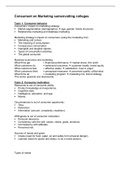Consument en Marketing samenvatting colleges
Topic 1: Consumer behavior
Consumers’ impact on marketing strategy:
Market segmentation (demographics age, gender, family structure).
Relationship marketing and database marketing.
Marketing strategy’s impact on consumers (using the marketing mix):
Marketing and culture.
The meaning of consumption.
Conspicuous consumption.
Intangible and tangible objects.
Types of consumption activities.
The global consumer.
Business economics and marketing
What firms get = financial performance market share, firm profit
What customers do = behavioral outcomes customer loyalty, brand equity
What customers feel = affective states satisfaction, trust or anger
What customers think = perceptual measures perceived quality, utility/value
What firms do = marketing program marketing mix, brand strategy.
This works upwards and downwards.
Topic 2: Consumer motivation
Resources to act of consumer ability:
Product knowledge and experience.
Cognitive style.
Intelligence, education, and age.
Money.
Circumstances to act of consumer opportunity:
Time.
Distraction.
Information (amount, complexity, repetition).
Willingness to act of consumer motivation:
Personal relevance.
Consistency with the self, values, needs, goals, emotions.
Inconsistency with attitudes.
Perceived risk.
Sources of needs and goals:
Innate (need for food, water, air and safety form physical danger).
Learned (need for power and status, to be a moral person).
Types of needs
, Functional (modeling, support, safety, order, physical well-being).
Symbolic (status, affiliation, belonging, achievement, self-control, independence).
Hedonic (reinforcement, sex, play, sensory stimulation, cognitive stimulation,
novelty).
Goal system (properties):
Equifinality: single goal associated with multiple means instrumentality:
perception of the ability of the means to achieve the goal (because of product
features, past experience).
Multifinality: multiple goals associated with the same multiple means perceived
value of a specific means: sum of the perceived value of all the goals it serves. It’s
only desirable if consumers have multiple goals, it can backfire when consumers
only have one goal (dilution effect: decreased perception of instrumentality of the
multifinal means with respect to each goal).
Self-regulation regulatory fit: people experience an increase in motivational
intensity when their manner of goal pursuit matches their self-regulatory
orientation this ‘’feeling right’’ experience generates value and leads to greater
persuasion.
Nurturance needs promotion goal (gain framed) self-regulatory goals.
Security needs prevention goal (loss framed) self-regulatory goals.
Dimensions of motivation:
Directs behavior (direction) goals, organization effort, reaching equilibrium.
Energizes behavior (intensity) drives, compulsions, deprivation/disequilibrium.
Sustains behavior (persistence) maintaining motivation, ability to change
course, importance of feedback.
Types of motivation:
Approach: moving towards a (positively valenced) goal.
Avoidance: moving away from a (negatively valenced) goal.
Intrinsic: the motivation to engage in behavior arises from within the individual
because it is naturally satisfying to you.
Extrinsic: involves engaging in a behavior in order to earn external rewards or
avoid punishment.
Rational: implies that consumers select goals based on totally objective criteria
such as size, weight, price, or miles per gallon.
Emotional: imply the selection of goals according to personal or subjective
criteria.
Motivation theories
Need theories (what):
Maslow’s hierarchy of needs: a theory which states that five categories of human
needs dictate an individual’s behavior (physiological, safety, love and belonging,
esteem and self-actualization).
Herzberg’s two factor theory: states that there are certain factors in the workplace
that cause job satisfaction while a separate set of factors cause dissatisfaction, all
of which act independently of each other.
Alderfer’s ERG theory: states that individuals can be motivated by multiple level of
need at the same time, and that the level which is most important to them can
change over time.
, McClelland’s human motivation theory: states that every person has one of three
main driving motivators the needs for achievement, affiliation, or power.
Process theories (how):
Vroom’s expectancy theory: assumes that behavior results from conscious
choices among alternatives whose purpose it is to maximize pleasure and
minimize pain.
Skinner’s reinforcement theory: behavior that is rewarded is likely to be repeated,
whereas behavior that is punished is less likely to recur. Reinforcement: an action
that follows directly from a particular behavior.
Adam’s equity theory: states that to be motivated, individuals need to perceive
that the rewards they receive for their contributions are fair, and these rewards
are similar to those received by their peers.
Locke’s goal setting theory: states that goal setting is essentially linked to task
performance. It states that specific and challenging goals along with appropriate
feedback contribute to higher and better task performance.
Topic 3: Problem recognition and information search
Managers response to problem recognition (structuring the marketing mix):
Developing a new product or altering an existing one.
Modifying channels of distribution.
Changing price policy.
Revising advertising strategy.
Factors influencing the actual and desired state:
Situation influences culture/social class, reference groups, product
consumption, change in financial status.
Consumer influences motives and needs, moods and emotions, previous
purchase decisions, physiological factors.
Marketing influences helping consumers recognizing problems, responding to
consumer problems, suppressing consumer recognizing problems (loyalty cards).
Types of benefit motives (to stimulate motivational arousal):
To optimize satisfaction.
To prevent possible future problems.
To escape from an issue.
To resolve a conflict.
To maintain the status quo.





